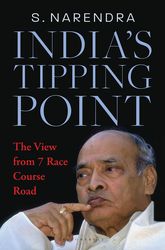Economies are often defined by the animal spirit. So, what was more suitable to represent the unshackling of the Indian economy after the 1991 reforms: an elephant or a tiger? Civil servant S. Narendra, information advisor to prime minister P.V. Narasimha Rao, was asked to explain his choice of the unshackled elephant symbol after Union minister Arjun Singh objected to it, saying the tiger represented new India better.
Narendra explained his choice in the presence of Rao and Singh: “India is a large, polyglot, federal, parliamentary democracy. The decision-making process is slow, but surefooted, the giant steps are impactful. Other countries already have tigers and lions. Moreover, the elephant is identified with Lord Ganesha.” The symbol may not have persisted, but the enduring legacy of the 1991 reforms continue to define the country and its growth trajectory.
Narendra has a penned an account of the turbulent 1990s. The author sheds light on behind-the-scenes activities and Rao’s mind on key issues. He also talks about the prime minister’s hesitancy in acting against ministers who came under the scanner in the Harshad Mehta scam, and later in dealing with the sugar import scam.
The author says that a few months before he accepted the position as Rao’s information advisor, Singh suggested to him that certain documents showing Rao in a negative light could be of interest to the media. Narendra turned the other way and it brought him on Singh’s crosshairs.
Narendra shares how he prepared Rao for a news conference after his first year in office, which coincided with the Harshad Mehta scam. In the presence of ministers Manmohan Singh and P. Chidambaram, Narendra posed tough questions to Rao. The rehearsal came in handy for Rao, who said at the presser: “I am not running away from any investigation. If Parliament wants JPC, they can have it. If the probe finds anyone guilty, they will not be in the government.” At the end of the presser held at the Siri Fort Auditorium, he bowed to 500 journalists with tears in his eyes. “Thank you, all of you have been kind to me,” he said.
The book sheds light on the cataclysmic event of Rao’s tenure―the demolition of the Babri Masjid. Narendra says Rao told him he was saddened by L.K. Advani and A.B. Vajpayee breaking their promises to him that it would not be demolished. Referring to Arjun Singh’s view that the Kalyan Singh government in Uttar Pradesh be dismissed, Rao said it was not tenable because Kalyan Singh had given a sworn affidavit in court and mere apprehension of a possible breach of a solemn promise did not constitute grounds for dismissal of the government. Narendra refutes allegations that Rao colluded with the BJP.
The author stresses on the importance of communication. He says governments should be transparent because it is pointless to hide things as they can come out at an inconvenient time. The role of advisors like Narendra was important during the time, when means of communication were limited. Astute media and information advisors could turn around negative sentiments.
Rao has remained celebrated after his death and is being increasingly discovered as a leader who changed the country. Narendra’s book is a valuable addition to literature on Rao and his tenure.
INDIA’S TIPPING POINT: THE VIEW FROM 7 RACE COURSE ROAD
By S. Narendra
Published by Bloomsbury
Pages 210; Price Rs699


